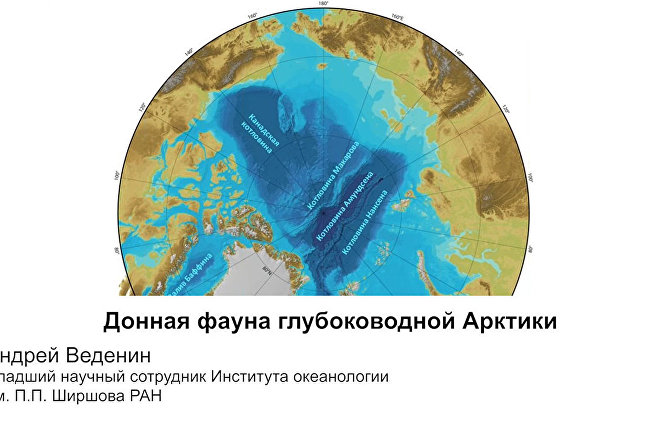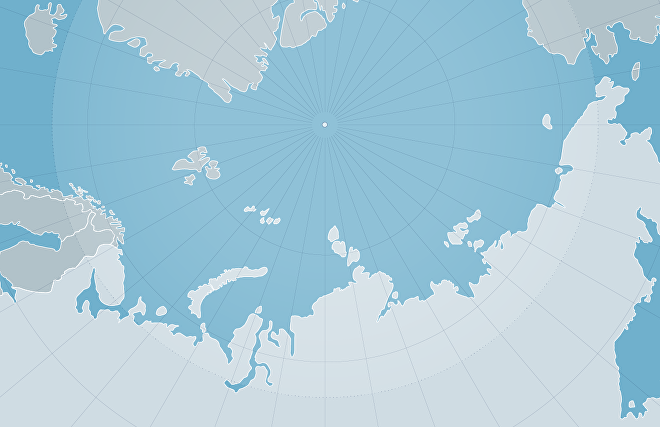Весной и летом в Арктику прибывает множество мигрирующих животных, причём за год некоторые из них в буквальном смысле совершают кругосветное путешествие, преодолевая огромные расстояния. Часть из них образует большие скопления на путях миграции, делая остановки для кормежки или линьки, а другие, наоборот, собираются в большом числе именно в районах размножения.
Правительства арктических государств взяли на себя обязательства выделить территории под заповедники и национальные парки. В настоящее время часть территории российской Арктики — природоохранные зоны. Здесь находятся национальные парки «Русская Арктика» и «Берингия», заповедники «Лапландский», «Кандалакшский», «Ненецкий», «Гыданский», «Большой Арктический», «Таймырский», «Усть-Ленский» и «Остров Врангеля», кроме того ряд федеральных заказников и многие региональные ООПТ
Чем ближе к Северному полюсу, тем беднее флора и фауна: далеко не все виды способны адаптироваться к экстремально низким температурам.
Например, на Таймыре в зоне лесотундры обитает 80 видов птиц и произрастает 250 видов сосудистых растений, а севернее, в зоне полярных пустынь, — лишь 12 и 50 соответственно.
Однако из этого правила есть и исключения: в Арктике обитают около половины из более чем 200 известных видов куликов и 70% общемировой популяции гусей.
Одно из самых красивых животных Севера — северный олень. Кроме того, это одно из главных животных в жизни коренных народов. Оленеводство стало традиционным занятием многих коренных народов примерно тысячу лет назад.
Наиболее многочисленная популяция домашних северных оленей обитает в Ямало-Ненецком автономном округе — около 665 тыс. животных. В Америке северных оленей называют «карибу» (при этом карибу немного больше северных оленей по размеру).
Многие народы Арктики, такие как саамы, ненцы и чукчи до сих пор занимаются разведением оленей. Это занятие даёт им пищу, одежду и кров, а также является источником дохода.
Коренные жители Аляски и Канады, однако, до сих пор предпочитают охотиться на карибу, а не заниматься оленеводством.
И у карибу, и у северных оленей полая шерсть, которая не даёт им замёрзнуть и помогает держаться на плаву. Олени — отличные пловцы, способные преодолевать широкие реки и даже лавировать между морскими льдинами.
Телята появляются на свет в начале весны. Благодаря запасу так называемого коричневого жира, с которым телята рождаются, они не замерзают. Уже спустя полтора часа после рождения телята могут бегать, поэтому от мигрирующего стада они обычно не отстают.
Миграции северных оленей — одно из самых захватывающих зрелищ в мире. Во время весенних переходов небольшие группы оленей объединяются, постепенно формируя огромные стада — до 500 тыс. особей. Осенью они снова разбиваются на группы и уходят зимовать в леса. Некоторые стада преодолевают до 5 тыс. км в год.
Овцебыки — ровесники мамонтов — самые крупные копытные Арктики. Они пасутся небольшими группами, обычно в низменностях и долинах рек, где в изобилии произрастает кустарник — их основная пища. Овцебыки, хотя и напоминают бизонов, находятся в более близком родстве с овцами и козами. В древности эти животные были гораздо более многочисленны, однако в период неолита их почти полностью истребили охотники.
Овцебыки — очень массивные травоядные: они могут весить до 300 кг и в холке достигать 150 см. Помимо людей на овцебыков охотятся волки. Спасаясь от опасности, эти животные быстро бегут, взбираются по горным склонам или же защищаются, пуская в ход свои массивные острые рога. Овцебыки прекрасно приспособлены к выживанию в суровых условиях Арктики: температура —40 °C, снегопад и сильный ветер им не страшны.

Белый медведь, или «нанук» на языке инуитов, — это самый большой наземный млекопитающий хищник. Однако и море играет существенную роль в жизни этих животных — отсюда и латинское название Ursus maritimus, «морской медведь». Белый медведь — северный родственник бурого, обитает на материковом побережье и островах Арктики.
Передвигаясь по льдинам, белые медведи преследуют свою излюбленную добычу — кольчатую нерпу. Иногда они отправляются в путешествие по льду, покрывающему центр Арктики.
Белые медведи могут плыть несколько дней без остановки, а их прекрасное обоняние позволяет им обнаруживать полыньи, куда приплывают подышать нерпы, причём на очень значительном расстоянии — свыше полутора километров.
В тех местах, где ледяной покров полностью исчезает к середине — концу лета, медведям приходится на несколько месяцев перебираться на берег и ждать, когда вода снова замёрзнет.
Новорождённые медвежата весят меньше килограмма, а вес взрослых самцов может достигать 800 кг. Рост крупных медведей в холке в среднем составляет 1,3-1,5 м. Медведицы меньше почти в два раза.
Белые медведи великолепно приспособлены к суровым арктическим условиям: их плотная шерсть отталкивает воду, чёрная кожа притягивает солнечные лучи, а толстый слой жира не даёт замёрзнуть. Молочно-белая окраска делает их незаметными для добычи. Наконец, белые медведи обладают способностью впадать в «спячку на ходу»: они бодрствуют, но долгое время обходятся без пищи.
Кроме того, в Арктике обитают песцы, горностаи, лисицы, полярные волки, росомахи, различные грызуны, зайцы.
Что касается птиц, то в Арктике сосредоточена почти половина видов береговых птиц мира. На арктическом побережье располагаются так называемые птичьи базары — колонии птиц. Самые массовые колонии в Арктике у чаек-моевок, толстоклювых кайр и люриков, остальные виды присутствуют на базарах в меньшем числе. В Северной Якутии обитает одна из самых редких птиц на Земле — стерх (белый журавль).
В Арктике обитают более 10 видов морских млекопитающих (это дельфины и киты — синие, горбатые, кашалоты и финвалы), а также по крайней мере 10 видов ластоногих — моржей и тюленей. Птицы, рыбы и морские млекопитающие особенно распространены в южной части океана.
Жизнь кипит и на дне океана, особенно на небольшой глубине, куда проникает солнечный свет. Так, у берегов Исландии учёные обнаружили представителей 4 тыс. видов, причём в различных районах проживают существенно отличающиеся друг от друга группы.
Великая Сибирская полынья в море Лаптевых — ещё одно место с высокой плотностью обитателей. Здесь кормятся моржи, кольчатые нерпы и лахтаки, а также гаги, морянки и другие морские птицы.
В арктических водах у берегов России, Гренландии, Канады и Аляски обитают белухи. Их относят к самым мелким видам китов: длина их тела составляет всего 5 м. Из-за огромного диапазона издаваемых звуков — от чириканья до рёва — этих животных называют морскими канарейками.
Белухи — социальные животные, поэтому живут группами, а иногда могут сбиваться и в целые стада численностью в несколько сотен особей. Лето они проводят около берега — в бухтах, мелководных заливах и устьях рек, где питаются рыбой, ракообразными и головоногими моллюсками.
Зимой белухи держатся кромки ледовых полей, но иногда проникают далеко в зону оледенения по узким водным тоннелям. В самые холодные месяцы белухи могут оказаться в ледовом плену и стать добычей белых медведей.
Благодаря способности к эхолокации белухи отлично ориентируются под водой и способны находить путь во льдах.
Родственные белухам зубатые киты — нарвалы — круглый год обитают во фьордах и бухтах Канады и на западе Гренландии.
Нарвалов называют морскими единорогами: у самцов в верхней челюсти находится длинный спиралевидный клык. В его наружном слое есть нервные окончания, а значит, как считают некоторые учёные, это особый сенсор, при помощи которого кит определяет давление воды, её температуру и содержание соли.
Нарвалы могут погружаться на очень большую глубину — 1,5 тыс. м. Под дрейфующими льдинами они ловят камбалу и других рыб.
В арктических и субарктических водах от Тихого до Атлантического океана обитают моржи.
У самцов — громадные клыки и жесткие волосы-вибриссы (орган осязания). Их масса может достигать 2 т. Большую часть своей довольно длинной (20-30 лет) жизни моржи проводят в сообществах на льдинах и побережьях богатых пищей вод. Своей огромной массы они достигают, питаясь животными, обитающими на морском дне: моллюсками, креветками, крабами, червями и холодноводными кораллами. Морж до сих пор остаётся очень ценной добычей для местных охотников, которые нашли применение практически каждой части его туши.


